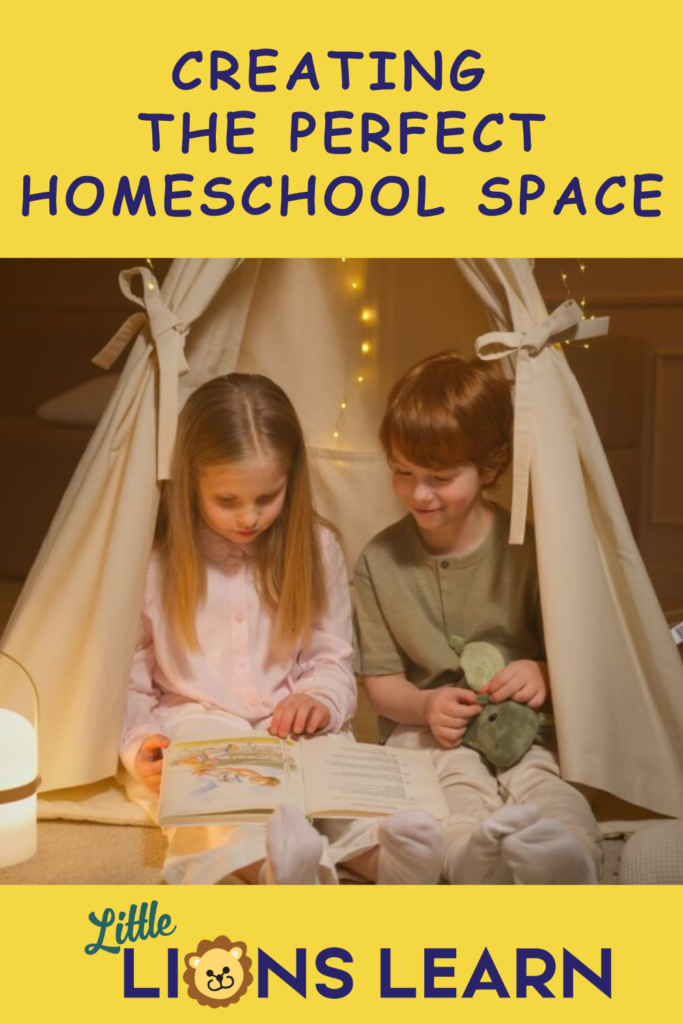Creating the Perfect Homeschool Space: Making the Most of Your Available Space
Having a dedicated learning space is essential for students to thrive academically. Whether you have a separate room or a small corner in your living area, a well-organized and inviting homeschool space can greatly enhance the learning experience. In this blog, we will explore creating the perfect homeschool space and provide tips on how to get your homeschool space ready for school utilizing the space you currently have.
*This page contains affiliate links and we earn a commission if you make a purchase through one of these links, at no extra cost to you. Disclaimer.
Assessing and Preparing the Space
The first step in setting up your homeschool space is to assess the available area and determine how it can be optimized for learning. Consider factors such as natural light, noise levels, and distractions. Here are some key tips for preparing the space:
a. Find a Quiet Spot: Look for a location in your home that is away from high-traffic areas and distractions like TV or gaming consoles. Ideally, choose a spot with minimal noise and interruptions.
b. Ensure Sufficient Lighting: Natural light is ideal, as it helps create a positive learning environment. Position your workspace near a window if possible. In case natural light is limited, invest in good-quality task lighting to avoid eye strain. We like to use lamps and string lights in our reading nook to make the learning environment comfortable.
c. Clear the Clutter: Decluttering the space is essential to create a focused and organized learning environment. Remove any unnecessary items and ensure you have ample storage solutions to keep materials and supplies neatly organized.
Comfort
Creating a comfortable and well-designed homeschool space is crucial for both productivity and physical well-being. Consider the following tips:
a. Furniture: Invest in a sturdy desk or use an old table with a comfortable chair that provides proper support for your child’s back. We bought balance balls and wiggle cushions to help the kids mix up their regular seating and stay focused.
b. Organize Supplies: Keep frequently used supplies such as pens, pencils, notebooks, and textbooks within easy reach. Utilize organizer bins, electronic device organizer shelves, or caddies to store and categorize our supplies effectively.
c. Personalize the Space: Let your child have a say in decorating the space with their favorite motivational quotes, artwork, or inspiring images. Personal touches can help create a sense of ownership and pride in their learning environment.

Creating a Functional Layout
Efficient use of the available space is essential, regardless of its size. Consider the following layout tips:
a. Zoning the Space: Divide the area into distinct zones, such as a study area, a reading nook, and a storage area. This helps create clear boundaries and facilitates smoother transitions between different activities.
b. Utilize Wall Space: Maximize vertical space by installing shelves, bulletin boards, or whiteboards on the walls. These can serve as display areas for artwork, a visual schedule, or a place to hang educational resources.
c. Mobile and Multi-functional Furniture: If you have limited space, consider using furniture that serves multiple purposes. For example, a storage ottoman can double as seating and provide additional storage space, or a bookshelf used for sitting.
Establishing a Routine and Flexibility
Finally, establishing a consistent routine and maintaining flexibility are crucial for a successful homeschool experience. Here are some suggestions:
a. Set a Schedule: Create a daily or weekly schedule that outlines the timing for different subjects and activities. Having a predictable routine helps students stay focused and organized.
b. Flexibility for Learning Styles: Allow for flexibility in the learning environment to accommodate different learning styles and preferences. Some students may prefer standing or working on the floor, while others thrive in a quiet and structured space.
c. Adapt and Evolve: As your child’s needs and interests evolve, be open to adapting the homeschool space accordingly. Regularly review and rearrange the space to accommodate changes in curriculum, interests, or study materials.
Conclusion
Creating the perfect homeschool space is essential for academic success and a positive homeschooling experience. By assessing and preparing the available space, focusing on ergonomics and comfort, creating a functional layout, and establishing a routine with flexibility, you can optimize your homeschool environment for your child’s needs. Remember, the most important aspect is to create a space that encourages engagement, focus, and a love for learning.
When it comes to creating the perfect homeschool space, flexibility is key. You don’t have to limit yourself to one designated area. Instead, consider what works best for you and your family. For example, if you’re tired of constantly clearing off the dining room table, try rearranging your living room. Invest in some affordable desks and create a central workspace. You can still keep your sofa and TV for educational videos and create a cozy reading nook. And don’t forget to dedicate a shelf or area for your curriculum materials. With a little creativity, you can design a homeschool space that meets your unique needs.

